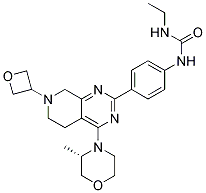All AbMole products are for research use only, cannot be used for human consumption.

GDC-0349 is a potent small molecule mTOR inhibitor with Ki of 3.8 nM. GDC-0349 inhibits downstream markers of mTOR, including phospho-4EBP1 and phospho-Akt(S473) in an in vivo PK/PD study in mouse, consistent with an inhibition of both mTORC1 and mTORC2 complexes. GDC-0349 inhibits tumor growth in a dose-dependent manner when dosed orally once daily in athymic mice in a MCF7-neo/Her2 tumor xenograft model. GDC-0349 is also efficacious in other xenograft models, including PC3 (PTEN null) and 786-O (VHL mutant). GDC-0349 is currently in a Phase I clinical trials in the treatment with solid tumors or Non-Hodgkin's lymphoma.
| Cell Experiment | |
|---|---|
| Cell lines | |
| Preparation method | Compound activity is tested in 10 point dose curves starting at the highest final concentration of 10 uM. They are serially diluted in 100% DMSO prior to further dilution with assay buffer. The reaction mixture (8 uls) containing 0.25 nM mTOR+GBL enzyme, 400 nM GFP-4E-BP1, 8 uM ATP, 50 mM Hepes pH 7.5, 0.01% Tween 20, 10 mM MnCl2, 1 mM EGTA, 1 mM DTT, 1% DMSO (+/- compound) is incubated at room temperature for 30 minutes. 8 uL of solution containing 2 nM Tb-anti-p4E-BP1 antibody & 10 mM EDTA diluted TR-FRET buffer is then added and incubated for 30 minutes to stop the reaction. The plate is scanned with the Envision plate reader. Ki values are calculated in Assay Explorer using the Morrison ATP-competitive tight binding equation for Ki apparent determination. |
| Concentrations | |
| Incubation time | |
| Animal Experiment | |
|---|---|
| Animal models | MCF7-neo/Her-2 mouse xenograft breast cancer model |
| Formulation | 0.5% methylcellulose/0.2% Tween 80 (MCT) |
| Dosages | 10, 20, 30, 40, 50, 60, 70, and 80 mg/kg QD for 24 days |
| Administration | orally |
| Molecular Weight | 452.55 |
| Formula | C24H32N6O3 |
| CAS Number | 1207360-89-1 |
| Solubility (25°C) | DMSO 90 mg/mL |
| Storage |
Powder -20°C 3 years ; 4°C 2 years In solvent -80°C 6 months ; -20°C 1 month |
| Related mTOR Products |
|---|
| RMC-4627
RMC-4627 is a selective mTORC1 inhibitor that activates 4EBP1 and inhibits tumor growth. |
| RMC-4529
RMC-4529 has an IC50 value of 1.0 nM against p-4E-BP1-(T37/46) in mTOR kinase cellular assay. |
| WYE-687 dihydrochloride
WYE-687 dihydrochloride is an ATP-competitive mTOR inhibitor with an IC50 of 7 nM. |
| Rapamycin-d3
Rapamycin-d3 |
| L-Leucine-d10
L-Leucine-d10 |
All AbMole products are for research use only, cannot be used for human consumption or veterinary use. We do not provide products or services to individuals. Please comply with the intended use and do not use AbMole products for any other purpose.


Products are for research use only. Not for human use. We do not sell to patients.
© Copyright 2010-2024 AbMole BioScience. All Rights Reserved.
